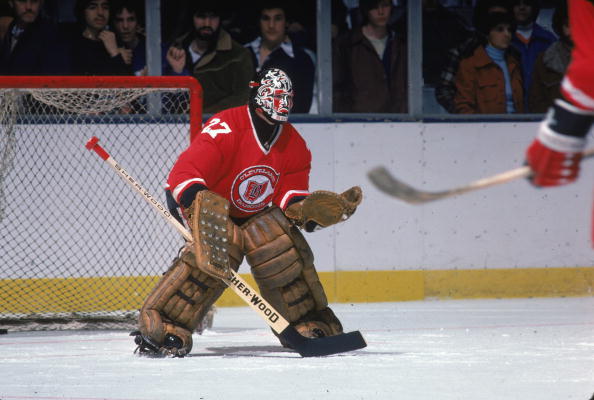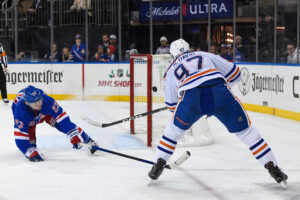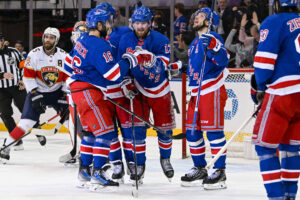The NHL Draft is just under a month away. The draft always provides plenty of drama and intrigue amongst fans and media. This has been true since the inception of the draft. While people tend to get excited about trades and prospects, there are other moments that leave people scratching their heads. Especially in the early years of the draft a lot of strange and crazy things could happen. In this NHL draft story we head to 1978 for a story that deals with expansion, relocation, mergers, draft picks and the vanishing Barons.
NHL Draft Stories: The Vanishing Barons
The story begins in 1967 when the NHL expanded the league from six to twelve. The league added teams in St Louis, Los Angeles, Pittsburgh, Minnesota, Philadelphia and Oakland. The team in Oakland is the focus today. The team was called the California/Oakland Golden Seals. While several of the original expansion teams, struggled to find their footing, the Golden Seals were the most tumultuous.
The team was struggling both on the ice and off it. Poor performances led to low attendance. This led to several denied (by the NHL) attempts to buy and relocate the team. A lawsuit from the Seals against the league for blocking the moves. A purchase that was approved, only for the company to file for bankruptcy a year into their purchase. All of this happened by 1970. Eventually, the team was (finally) sold (for the first time) and was able to stay in the Bay area market.
Crisis Averted… Not So Much
The new owner, Charles O. Finley tried several gimmicks to try to make the team more popular, including changing the team colours and logo. Renaming the team the Bay Area Seals to start the 1970-71 season only to revert back to California after two games. Making the players wear white skates. None of the gimmicks worked as the Seals finished dead last in the league and did nothing to engage the fan base. The only lasting legacy of Finley’s gimmicks was the addition of player names on the back of jerseys.
Under Finley, the team began to slightly improve. Unfortunately, the rival WHA came on the scene and began playing players’ big-money contracts. Finley was not willing to match the salaries, so the Seals lost many of their best players to the rival league.
By 1973 Finley lost patients with the team and was looking to sell. There was a potential bid from a group in Indianapolis that would relocate the team, but again the league blocked the sale. Ultimately, the league bought the team from Finley during the 1973 season.
By 1975 another failed purchase and move, the league announced that if no local owners would step up, the team would be liquidated. San Francisco hotel magnate Melvin Swig stepped up and purchased the team. The plan was to move the team to San Francisco to a new arena that was supposed to be built. Unfortunately, the new arena never materialized and Swig moved the team to his hometown Cleveland for the 1976-77 season.
Hockey in Cleveland
The Seals were no more and the Cleveland Barons were born. Because of the rushed nature of the sale, the Barons did not have enough time to promote themselves to their new market. The team never recovered. The team could barely draw 10,000 fans to their home games.
It’s hard to believe, but the team was a worse draw in Cleveland than it was in Oakland. In an attempt to make it work, the owners poured money into the team for the 1977-78 season in hopes of making them competitive. While the team showed some signs, they ultimately fell short of the playoffs and failed to gain any traction in the Cleveland sports landscape.
The Merger
After the 1978 season, the Barons owners were looking to offload the team. During this time, a similar situation was going on in Minnesota. The North Stars were struggling to gain traction in the Minnesota sports landscape. The league worried both teams might fold approved a proposal that merged the two struggling teams.
The team would reside in Minnesota under the North Stars name and colours with the Barons owners taking control of the new team. With the Barons being absorbed into the North Stars, there were some loose ends that needed to be dealt with. A player dispersal, draft order, and any Barons picks owned by other teams through trades. Good thing the deal closed on June 14, 1978, the day before the Draft. Read that again: The. Day. Before. The. Draft.
1978 Draft
With (apparently) enough time to throw together a dispersal draft and run the amateur draft, things went ahead as scheduled on June 15th. Two players were selected in the dispersal draft. Next, the focus went to what to do about the draft picks owned by other teams.
The Washington Capitals and New York Islanders held the Barons’ second and fourth-round picks respectively. It was easy enough to adjust the draft order by removing the Barons from the list and bumping everyone else up. However, it’s not so simple when teams that exist hold some of those picks. Clearly, there were two paths to take here. Both teams keep the picks or both teams forfeit the picks.
The… Solution?
Well, since this was the NHL and it was the 70s, their solution made absolutely no sense. The Capitals were able to keep their pick in the second round and selected defenceman Paul MacKinnon. The league would then strip the Islanders of their fourth-round pick acquired from the Barons because, why not. Maybe NHL President John Zeigler dusted off the old wheel from the 1970 draft and let it make the decision.
There was probably some vague explanation about the nature of both trades – the Islanders and Barons swapped fourth-round picks as part of a bigger trade, while the Capitals had acquired the only pick in their trade – was made but it still doesn’t make sense or seem very fair. The Islanders, to their credit, didn’t let the slight hinder them in any way. With four Stanley Cups from 1980-83, everyone just agreed to forget this whole ordeal ever happened.






